Home | Image Library | Blog | Purchasing | Contact | About | Search
June 16, 2016 - Butterfly Valley Botanical Area
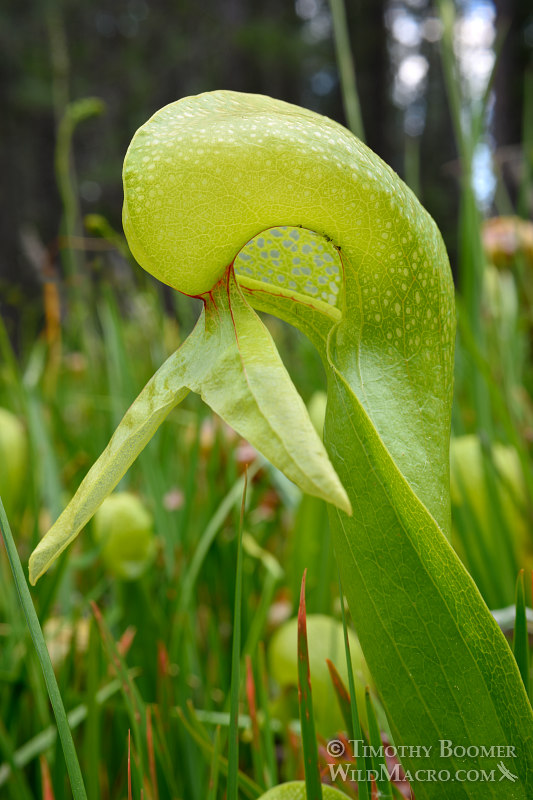
There is something so intriguing about carnivorous plants. Is it that they defy the basics of plant life we were taught in grade school? Are they somehow more sentient than "regular" plants? Or maybe we're just happy that they're helping to keep the mosquito population at bay. Whatever the reasons, there's no denying the fact these organisms have been successful in capturing not only ill-fated insects, but the fascination of people worldwide (myself included). Indeed, the California pitcher plant (Darlingtonia californica) has been near the top of my photographic wish list for quite some time. And thanks to my trip on June 5th to Butterfly Valley Botanical Area, I feel that I finally made some compelling images of the Golden State's flagship carnivorous plant.
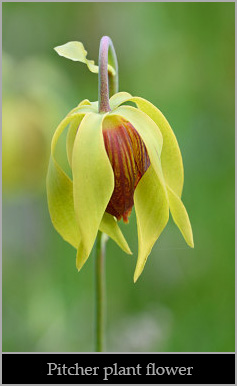 Before I dive into my account of this outing, however, I'll share a couple of my mistakes from my visit in 2014. My first gaffe was arriving in early May. There were several Darlingtonia flowers coming into bloom, but all of the pitchers were just the dried out, rather pathetic-looking remains from the previous year. Don't get me wrong — the flowers were quite attractive, but for this particular plant, I was really more interested in the "business end," so to speak. My next mistake was the route I chose. Based on satellite imagery, Butterfly Valley Road appeared to be the easiest and most direct path to the Sweetwater Marsh or Darlingtonia Bog. Unfortunately, this aerial view did nothing to warn me of the steep, narrow dirt road filled with deep ruts and unwelcoming signage and glares from local residents. Against my better judgment, I continued to navigate my two-wheel-drive sedan to the bog, but it was a slow and stressful ordeal that I would definitely not recommend.
Before I dive into my account of this outing, however, I'll share a couple of my mistakes from my visit in 2014. My first gaffe was arriving in early May. There were several Darlingtonia flowers coming into bloom, but all of the pitchers were just the dried out, rather pathetic-looking remains from the previous year. Don't get me wrong — the flowers were quite attractive, but for this particular plant, I was really more interested in the "business end," so to speak. My next mistake was the route I chose. Based on satellite imagery, Butterfly Valley Road appeared to be the easiest and most direct path to the Sweetwater Marsh or Darlingtonia Bog. Unfortunately, this aerial view did nothing to warn me of the steep, narrow dirt road filled with deep ruts and unwelcoming signage and glares from local residents. Against my better judgment, I continued to navigate my two-wheel-drive sedan to the bog, but it was a slow and stressful ordeal that I would definitely not recommend.
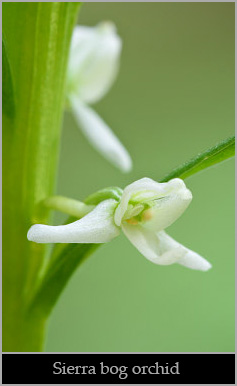 This time around, I had the good sense to follow the directions provided by the forest service. This route, which begins on Blackhawk Road, certainly covers more miles and has its fair share of potholes, but I found it to be reasonably well maintained and a much more enjoyable drive overall. Be advised that quite a bit of dirt gets kicked up in the process; if you're traveling in a caravan, it would behoove you to be in the lead vehicle.
This time around, I had the good sense to follow the directions provided by the forest service. This route, which begins on Blackhawk Road, certainly covers more miles and has its fair share of potholes, but I found it to be reasonably well maintained and a much more enjoyable drive overall. Be advised that quite a bit of dirt gets kicked up in the process; if you're traveling in a caravan, it would behoove you to be in the lead vehicle.
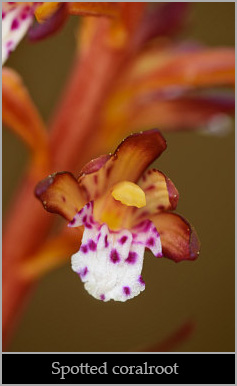 Shortly after passing the large Butterfly Valley sign, I pulled over to check out the area known as Fern Glen. Seven kinds of orchids have apparently been found here, but I only saw three: Sierra bog orchid, spotted coralroot and a single mountain lady's slipper. The Sierra bog orchids are quite tall and easily found right along the edge of the road. I felt like I was seeing spotted coralroots everywhere, and I'm sure there were plenty more that went unnoticed...I guess you could call those ones unspotted coralroots. I admired the mountain lady's slipper and quickly moved on to photograph the bog wintergreen and little prince's pine.
Shortly after passing the large Butterfly Valley sign, I pulled over to check out the area known as Fern Glen. Seven kinds of orchids have apparently been found here, but I only saw three: Sierra bog orchid, spotted coralroot and a single mountain lady's slipper. The Sierra bog orchids are quite tall and easily found right along the edge of the road. I felt like I was seeing spotted coralroots everywhere, and I'm sure there were plenty more that went unnoticed...I guess you could call those ones unspotted coralroots. I admired the mountain lady's slipper and quickly moved on to photograph the bog wintergreen and little prince's pine.
 I was actually pleasantly surprised by how many spiders I found in the area. Each time I received another bite from a mosquito, I comforted myself with the thought that it might later become a meal for one of my little arachnid friends. I was really in a plant photography mindset, but I came across one particular long-jawed orb weaver that was just too elegant to pass up.
I was actually pleasantly surprised by how many spiders I found in the area. Each time I received another bite from a mosquito, I comforted myself with the thought that it might later become a meal for one of my little arachnid friends. I was really in a plant photography mindset, but I came across one particular long-jawed orb weaver that was just too elegant to pass up.
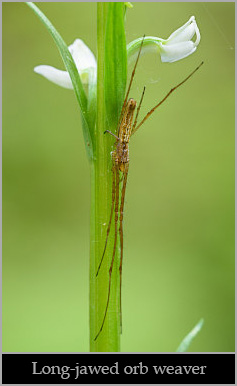 After finishing up at Fern Glen, I continued on to the main attraction at the Darlingtonia Bog. At first glance, it appeared I had still arrived too early in the season, as the vast majority of the plants were either just getting started or were last year's remnants. It seems like mid to late June would be ideal. Determined to make the most out of my eight-hour round trip drive, however, I continued to search for suitable specimens. As I carefully traversed the bog, I entertained myself with the following thought: Are vegetarians allowed to eat carnivorous plants? I began envisioning the vegetarian police raining in from the sky to issue citations, but fortunately, I found an acceptable plant to photograph before my imagination went too wild.
After finishing up at Fern Glen, I continued on to the main attraction at the Darlingtonia Bog. At first glance, it appeared I had still arrived too early in the season, as the vast majority of the plants were either just getting started or were last year's remnants. It seems like mid to late June would be ideal. Determined to make the most out of my eight-hour round trip drive, however, I continued to search for suitable specimens. As I carefully traversed the bog, I entertained myself with the following thought: Are vegetarians allowed to eat carnivorous plants? I began envisioning the vegetarian police raining in from the sky to issue citations, but fortunately, I found an acceptable plant to photograph before my imagination went too wild.
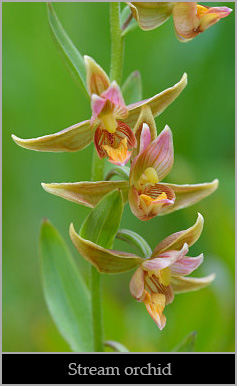 Distant rumblings persisted throughout my jaunt in the bog, but the clear sky kept my mind at ease...at least for a while. At some point while I was deeply engrossed in my photography, the sky had become quite ominous and those distant rumblings had transformed into resounding bellows whose direction of origin was no longer obvious. Not wanting to get caught in the middle of an electrical storm with a large aluminum tripod and sensitive camera equipment, I started to head back to my car. Before I made it out of the bog, however, I finally found the perfect specimen. I looked back and forth from the pitcher plant to the sky a couple times and decided to just go for it. I pulled out my gear again, positioned my tripod flat on the wet ground and proceeded to capture my favorite image of the day (see top).
Distant rumblings persisted throughout my jaunt in the bog, but the clear sky kept my mind at ease...at least for a while. At some point while I was deeply engrossed in my photography, the sky had become quite ominous and those distant rumblings had transformed into resounding bellows whose direction of origin was no longer obvious. Not wanting to get caught in the middle of an electrical storm with a large aluminum tripod and sensitive camera equipment, I started to head back to my car. Before I made it out of the bog, however, I finally found the perfect specimen. I looked back and forth from the pitcher plant to the sky a couple times and decided to just go for it. I pulled out my gear again, positioned my tripod flat on the wet ground and proceeded to capture my favorite image of the day (see top).
It began to sprinkle just as I was finishing up, and by the time I made it back to Hwy 70, I found myself in the middle of an intense downpour. This conveniently rinsed most of the day's dust from my car, but I figured my photographic adventures for the day had come to an end. As it turns out, the rain actually tapered off in time for me to capture some stream orchid pictures on my way home, but I had better leave it at that before the blog police break down my door and confiscate my keyboard for robbing my visitors of all their free time.
Next Entry: Carson Pass - 8/3/16
Previous Entry: Mountain Lady's Slipper - 5/27/16
Blog Archive
![]()
Interested in buying a print or licensing a picture? Click on the purchasing link for more information or contact us with any questions you may have. Thanks for looking!
Back To Top
All images & text copyright Timothy Boomer. All rights reserved worldwide.